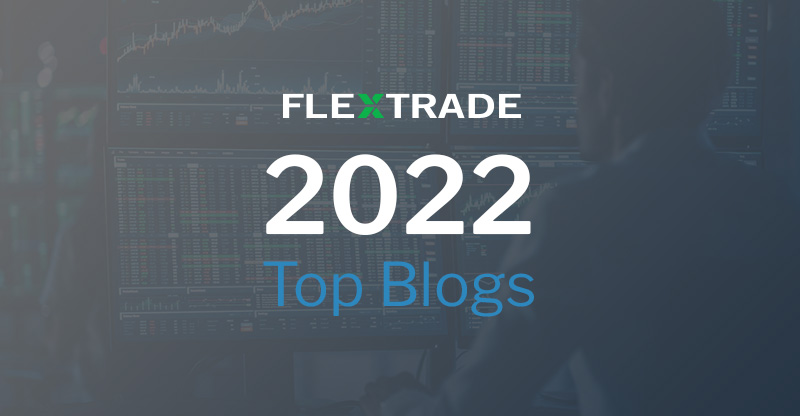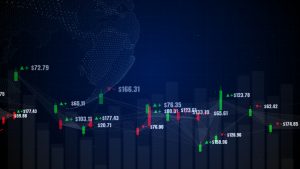A Year in Review: Top Blogs in 2022
December 15, 2022 | By: Ivy Schmerken

As we look back on this year, topics such as institutional adoption of digital asset trading, European trading in response to geopolitical risk, and the SEC’s plans to revamp U.S. stock trading rules dominated the headlines. In 2022, we covered those topics and much more including the growing sophistication of AlgoWheel, and the evolution of the buy-side fixed income EMS.
Which topics attracted the most attention from readers?
The rise of new secondary platforms for trading private shares, the renewed focus on FX data and analytics for evaluating algos and liquidity providers; and the major risks driving trading in 2022 were among the top blogs. On the technology front, some of the key topics were the role of the fixed-income EMS in aggregating data and protocols; the demand for risk data in the front office via the OEMS; and liquidity-based routing within FlexAlgoWheel.
Given this background, here is a list of the “most read” FlexTrade blogs for 2022.
1. The New Wave in Private Securities Marketplaces
2. What’s Ahead for FX Algo Trading and TCA
3. Top Risk Trends Driving Markets in 2022
4. Equity Market Structure Revamp Stimulates Debate
5. FlexAlgoWheel’s Best Kept Secrets
6. Risk Data Moves Upstream via the Buy-Side OEMS
7. Buy Side Tackles FX Data Challenges with Liquidity Analytics and TCA
8. Stablecoin Fiasco Raises Questions for Institutional Adoption of Digital Assets
9. Fixed-Income EMS Evolves with Data Protocols and Automation
10. Auctions Loom Large in SEC’s Market Overhaul
1.The New Wave in Private Securities Marketplaces

With companies staying private far longer, a new wave of secondary platforms has emerged to develop a market for trading private shares.
“Despite its growth, private equity is still in the early stages of trying to understand how to collect the information, how to get the engagement, how to move into a more transparent world,” said Jonathan, Clark, President, USA at InvestX Capital Ltd.
Even major exchanges are looking to play a role in private securities marketplaces. For example, ICE made a strategic investment in blockchain pioneer tZERO whose regulated alternative trading system (ATS) supports trading in tokenized securities of private companies, while LSEG took a strategic stake in Floww, a platform connecting startups with financiers.
2.What’s Ahead for FX Algo Trading and TCA
A focus on data and analytics is permeating every decision in foreign exchange (FX) trading, according to a virtual event on market structure sponsored by Tabb Forum and the Full FX.
From selecting FX algorithms to evaluating liquidity providers, and identifying hidden costs, there is an emphasis on interpreting data.
“The big challenge with data is to get it standardized so we can do some observations around executions and make sure we are analyzing like- for-like,” said Richard Turner, Senior Trader, Currency Solution, Insight Investment, which uses algorithms to meet the firm’s best execution regulatory requirements.
3.Top Risk Trends Driving Markets in 2022

Concerns about Russia’s escalating tensions with Ukraine, the Federal Reserve’s plans to raise interest rates, and how aggressively the central bank will fight inflation are among the top risks driving stock market volatility in 2022.
Some of the newer risk trends that hedge funds and asset managers are monitoring include data misinformation and crowdsourced volatility, according to a virtual panel, “Data Minds: The Risk Outlook for 2022,” sponsored by data provider Wall Street Horizon.
“With the efficiency of frictionless communications, a very small group of people can connect with a huge number of people and that creates a new type of volatility event said Jon Trowbridge, Senior Director of Risk Management at online brokerage firm TradeStation Group.
4.Equity Market Structure Revamp Stimulates Debate

SEC Chairman Gary Gensler’s plan to revamp the rules for U.S. stock trading is stirring debate among market participants, arguing whether the sweeping overhaul is necessary, while others favor a holistic review.
In a June 8 speech, Gensler suggested the idea of “order-by-order competition,” which would require brokers to route individual orders to a transparent auction process where other firms would compete to match buy and sell orders.
“Having more competition is critical,” said Joe Wald, managing director and co-head of electronic trading at BMO Capital, an institutional broker-dealer. “There is midpoint liquidity on exchanges and ATSs, but because of today’s market structure the retail liquidity is not there to interact with directly,” said Wald.
5.FlexAlgoWheel’s Best Kept Secrets

Over the past five years, FlexAlgoWheel has become an essential decision support and workflow automation module used by a rapidly growing number of FlexTrade EMS and OEMS users on the buy-side and sell-side.
“With feedback and suggestions from our clients, the product is continuously evolving, progressing from automating the easy orders to managing the more complex, less liquid names for algorithmic execution,” wrote Sharat Kumar is Vice President, Head of Algorithmic and Analytical Solutions at FlexTrade.
This article examines recent developments in FlexAlgoWheel, such as switching algo strategies, tuning algo parameters in response to real-time data, handling basket/portfolio trading, and liquidity-based order routing, as well as future expansion to other asset classes.
6.Risk Data Moves Upstream via the Buy-Side OEMS
With uncertainty weighing on financial markets, the need to integrate with risk models and consume risk data for intraday calculations is moving upstream on the buy-side trading desk.
Recently, risk monitoring has become a front-office concern with portfolio managers seeking more transparency into risk factors. This is particularly relevant to hedge funds and asset managers applying factor investing to their portfolios.
“The ability to consolidate risk model data from external systems onto the OEMS blotter provides advantages to the buy side,” wrote Jose Cortez, CFA, who is Vice President of Buy-Side OEMS Sales at FlexTrade. “With our open architecture framework, FlexONE integrates disparate sets of data, whether its risk, ESG, or other types of data, to use throughout the system,” said Cortez.
7.Buy Side Tackles FX Data Challenges with Liquidity Analytics and TCA

Collecting and storing data for analysis in an OTC market such as foreign exchange is important to ensuring best execution and improving the pricing received from liquidity providers. But, capturing that data is still challenging, according to buy-side FX traders speaking on a TradeTech FX webcast.
There is a shift away from TCA to what is known as liquidity provision analytics (LPA) where the buy-side is monitoring their liquidity, particularly streaming prices that update multiple times a second throughout the entire day.
Panelists said TCA is no longer a check-the-box exercise. “TCA is a value-add that creates a feedback loop. If you start with enough data and enough of the trades… that feeds the pre-trade analytics, which feeds the trading, and then feeds TCA which goes round and round,” said panelist Nick Wood, head of execution at Millennium Asset Management.
8.Stablecoin Fiasco Raises Questions for Institutional Adoption of Digital Assets

Recent turmoil in the stablecoin market has shaken up cryptocurrency trading and the world of decentralized finance, accelerating more calls for regulatory oversight as mainstream financial institutions watched this playout.
“The big question is whether the USD/Luna fiasco would cause a pullback in institutional adoption of crypto and digital assets by a year or two, said Dushyant Shahrawat Director -Strategic Insights & Advisory, FinTech Investment Banking at Rosenblatt Securities at the firm’s virtual fintech event.
Panelists agreed the stablecoin collapse is a temporary setback due to a “design flaw” in the two types of stablecoins in the market, and that the industry will overcome it.
The key challenges to institutional adoption of DeFi will be identity, collateralization, and KYC which are requirements for regulated institutions, predicted several panelists.
9.Fixed-Income EMS Evolves with Data Protocols and Automation
Fixed-income data feeds have proliferated in the last few years and more institutions execute orders on electronic trading venues with diverse protocols. Yet, managing data and sourcing liquidity across disparate platforms has become more challenging.
“The buy side doesn’t always have a full picture of the marketplace since the OTC bond market relies heavily on pre-trade data from bilateral relationships and multiple data sources, and an EMS is well positioned to consolidate, store, and digest this data for better informed trading decisions,” wrote Stefano Dallavalle, Fixed Income Product Manager for FlexTrade’s fixed-income EMS solution.
In fact, EMSs are at the crossroads of providing an integrated solution that connects with multiple venues, protocols, and data sources, wrote Dallavalle.
10.Auctions Loom Large in SEC’s Market Overhaul

The Securities and Exchange Commission’s plans to overhaul stock trading rules are starting to materialize, and the first set of proposed rules to emerge could focus on routing small retail orders to auctions with midpoint prices.
However, the industry’s top wholesalers and brokerage executives speaking at the STA National Market Structure conference in October emphasized that the stock market is functioning well for retail investors and cautioned against making a litany of changes that could lead to worse results.
In an interview at STA, SEC Commissioner Hester Peirce voiced concerns about making dramatic changes to the way the market works. “For retail investors, they do get good execution in the markets. The markets are liquid. And so how can we take care as we’re approaching this project?” commented Peirce.

